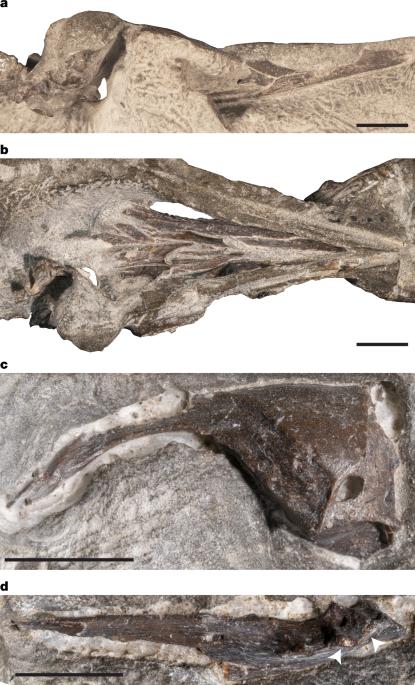白垩纪南极鸟类头骨揭示了早期鸟类生态多样性
IF 48.5
1区 综合性期刊
Q1 MULTIDISCIPLINARY SCIENCES
引用次数: 0
摘要
代表白垩纪冠枝鸟类谱系的化石非常罕见,但对阐明早期鸟类分化的主要生态转变至关重要。已知最早的冠鸟是Vegavis iaai1-5,这是一种来自南极洲白垩纪晚期(6920 - 6840万年前)的以脚为动力的潜水动物,其系统发育亲缘关系存在争议。通过系统发育分析,Vegavis最初被发现是一种茎无虫(鸭及其密切相关的物种)1,2,11,后来被发现是一种anserformes(水禽)的茎成员7-9,或在禽类之外10。在这里,我们报告了一个新的,几乎完整的Vegavis头骨,为其摄食生态学提供了新的见解,并展示了支持冠群鸟类中水禽位置的形态。Vegavis有鸟类的喙(没有牙齿和缩小的上颌骨)和大脑形状(过度膨胀的大脑和腹侧移位的视叶)。颞窝被很好地挖掘和扩张,表明这只鸟有肥大的下颌肌肉组织。喙窄而尖,下颌骨缺乏关节后突。这些特征加在一起构成了一种进食装置,它不同于任何其他已知的反形动物,但与其他现存的水下捕食鸟类(例如,grebes和loons)的进食装置相似。白垩纪Vegavis的出现,在已知的Galloanserae(水禽和陆禽)中具有独特的进食生态,进一步表明,最早的anserform分化是以现存多样性中没有代表的进化实验为标志的3,11 - 13。在南极半岛詹姆斯·罗斯盆地发现的一具几乎完整的新维加维斯头骨化石,为了解维加维斯的摄食生态提供了洞见,并展示了在冠类鸟类中支持水禽位置的形态。本文章由计算机程序翻译,如有差异,请以英文原文为准。

Cretaceous Antarctic bird skull elucidates early avian ecological diversity
Fossils representing Cretaceous lineages of crown clade birds (Aves) are exceptionally rare but are crucial to elucidating major ecological shifts across early avian divergences. Among the earliest known putative crown birds is Vegavis iaai1–5, a foot-propelled diver from the latest Cretaceous (69.2–68.4 million years ago)6 of Antarctica with controversial phylogenetic affinities2,7–10. Initially recovered by phylogenetic analyses as a stem anatid (ducks and closely related species)1,2,11, Vegavis has since been recovered as a stem member of Anseriformes (waterfowl)7–9, or outside Aves altogether10. Here we report a new, nearly complete skull of Vegavis that provides new insight into its feeding ecology and exhibits morphologies that support placement among waterfowl within crown-group birds. Vegavis has an avian beak (absence of teeth and reduced maxilla) and brain shape (hyperinflated cerebrum and ventrally shifted optic lobes). The temporal fossa is well excavated and expansive, indicating that this bird had hypertrophied jaw musculature. The beak is narrow and pointed, and the mandible lacks retroarticular processes. Together, these features comprise a feeding apparatus unlike that of any other known anseriform but like that of other extant birds that capture prey underwater (for example, grebes and loons). The Cretaceous occurrence of Vegavis, with a feeding ecology unique among known Galloanserae (waterfowl and landfowl), is further indication that the earliest anseriform divergences were marked by evolutionary experiments unrepresented in the extant diversity3,11–13. A new, nearly complete fossil skull of Vegavis from the James Ross Basin, Antarctic Peninsula, provides insight into its feeding ecology and exhibits morphologies that support placement among waterfowl within crown-group birds.
求助全文
通过发布文献求助,成功后即可免费获取论文全文。
去求助
来源期刊

Nature
综合性期刊-综合性期刊
CiteScore
90.00
自引率
1.20%
发文量
3652
审稿时长
3 months
期刊介绍:
Nature is a prestigious international journal that publishes peer-reviewed research in various scientific and technological fields. The selection of articles is based on criteria such as originality, importance, interdisciplinary relevance, timeliness, accessibility, elegance, and surprising conclusions. In addition to showcasing significant scientific advances, Nature delivers rapid, authoritative, insightful news, and interpretation of current and upcoming trends impacting science, scientists, and the broader public. The journal serves a dual purpose: firstly, to promptly share noteworthy scientific advances and foster discussions among scientists, and secondly, to ensure the swift dissemination of scientific results globally, emphasizing their significance for knowledge, culture, and daily life.
 求助内容:
求助内容: 应助结果提醒方式:
应助结果提醒方式:


